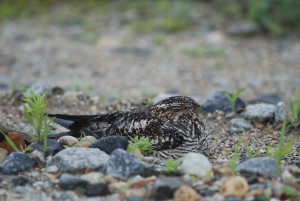Think of a bird with such exquisite camouflage that even the sharpest human eyes fall short, a bird that occupies the mysterious twilight realm after days end but before nightfall. It lives in this thin space, designed to be heard and not seen, known only by its evocative call, Whip-poor-will. It is no wonder that such a bird might give rise to strange tales.
Aristotle, who would probably have been most familiar with the European Nightjar, a close cousin to the Whip-poor-will, wrote that “flying to the udders of she-goats, it sucked them.” The apocryphal behavior gave rise to the scientific name Caprimulgidae for the large family of more than 90 species of Whip-poor-wills, Nighthawks, and Nightjars. According to Edward Gruson’s wonderful book Words for Birds, it derives from the Latin caper, “goat”, and mulgere “to milk”.
The sense of mystery surrounding these birds persists to this day, as does the generic name Goatsucker. It took me a full decade to finally see a Nightjar in Ireland, where they are rare, and my fascination with the family continues. There are eight species in North America, though two of these are restricted to the extreme south of Texas. In New Hampshire we have only the Common Nighthawk and the Eastern Whip-poor-will, though a sharp-eared birder used her iPhone to record a Chuck-will’s-widow on June 3rd in Newton, the first state record for this southern species.
The Nighthawk though a common fall migrant is a rare breeder in the Granite State, nesting only in a few localities including Keene, Concord, and the Ossipee Pine Barrens. Eastern Whip-poor-will though less rare, is still uncommon and declining. I was giving a talk in Pelham just outside Nashua recently and a person in the audience asked where the Whip-poor-wills had gone. Once common in the Nashua area, their pine barren habitat proved equally attractive to the home builders as the birds. Most of southern New Hampshire’s pine barrens have been lost to development and with them the Whip-poor-wills.
The Ossipee Pine Barrens are a remaining stronghold for the species in the state, and Common Nighthawks also nest here. Much of the area is protected thanks to the Nature Conservancy, whose tag line “Saving the World’s last great places” seems appropriate. In this case it might read “Saving New Hampshire’s last great places”. In stark contrast to Nashua, I met a woman who lamented that the Whip-poor-wills in the Ossipee Pine Barrens keep her up at night. I related the anecdote from Nashua to convince her of her good fortune, and I was reminded of a similar situation from my homeland. My dad told me how, when he was a kid, Corncrakes were common in every Irish county and would call incessantly through the night. Like the lady in Ossipee, people would complain about their never-ending rasping call. Then came mechanized farming, and the population of Irish Corncrakes almost vanished. Decades later, their numbers are still in the low hundreds. All that remains across much of the Irish landscape is the memory of their once commonplace call. We should ensure we don’t let the Whip-poor-will or Nighthawk go the same way. New Hampshire Audubon has more information on how you can help at www.nhaudubon.org. Click on the following link for a soundscape from the Ossipee Pine Barrens from June 13th.

Thanks for posting this and the SoundCloud recording. I will be sure to listen for the whippoorwill. Without having heard it, I think if I heard the whipporwill out my window it might have blended in with the sound of our ducklings peeping–although of course we get the ducks inside before full dark when the predators come out for dinner!